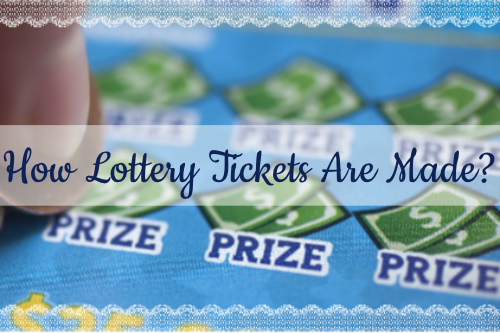The Curious Story of How Lottery Tickets Are Made

Where does the story of the lottery begin? Are there specific regulations and requirements for the making and printing of lottery tickets? This is the case, especially when it comes to nationally-regulated lotteries that are organized by an official entity.
But we’re not going to dig in the regulations and the administrative specifics of lotteries coming into existence. Instead, we will try to answer curious questions like what lottery tickets are made of and how scratch-off tickets are distributed.
Some Historic Reference
Before attempting to answer the question of how lottery tickets are made, let’s go back in time.
When it comes to standard lottery tickets for draw-style games, there aren’t too many surprises. The tickets themselves aren’t made in advance. Rather, play slips are printed at retail venues at the time someone goes to make a purchase.
There’s nothing special about the paper, and play slip itself. All the essential information is stored in a digital database containing the details about the winning numbers and the tickets.
Things are a bit more fun and exciting in the realm of instant lottery games.
It all started with gaming cards in the 1950s and 1960s in the US. These gaming cards were popular in grocery stores and gas stations. A graphic symbol had to be matched on the printed card for its owner to claim a prize.
Some of these cards had a waxy coating that needed to be rubbed off to reveal the symbol located underneath. A man called John Koza got interested in the concept. A computer science professor, Koza, believed that instant games like the ones available at grocery stores could be launched on a national level and turned into a significant success.
As a computer scientist, John Koza partnered up with a local promoter called Dan Bower. The duo launched a company called Scientific Games Corporation in Atlanta, and the entity was already operational by 1973.
At the time, only eight states had lotteries. Koza and Bower flew across the country to explain their concept of instant win tickets and popularize the idea. They met success in Massachusetts, where the head of the lotto commission agreed to give the concept a shot. He ordered 25 million of Koza’s instant tickets to do a test run.
Koza and Bower started working on the order, attempting to come up with an algorithm for the printing of the tickets. They also come up with a recipe for a proprietary silicone coating that protected the secret of the winning ticket and could only be rubbed out with a coin.
Those very first scratch-off tickets were called The Instant Game, and the maximum prize was set at 10,000 dollars. By the end of the first week of ticket distribution, players in Massachusetts had spent 2.7 million dollars on the new game.
And that’s how an international craze was started.
How Are Instant Lottery Tickets Made and Distributed Today?
Today, things have become a bit more hi-tech, but the original concept has been kept.
There are two major manufacturers of scratch-off tickets in America. One of them is… you’ve guessed it… the Scientific Games Corporation launched by Koza and Bower. The other entity is the Pollard Banknote. These companies have production facilities in the US, Canada, Germany, Brazil, Australia, and Chile, to name a few. Several other smaller manufacturers also print lottery tickets in America, Europe, and Asia.
Each scratch-off ticket is printed on paper, but sometimes plastic is also used to make the cards a bit more resilient. An opaque substance like latex is used to hide important information like symbols and numbers that reveal the presence or absence of a win.
The original coating was changed in 1980. It was found to be unsafe, and adhesives specialist Jerome Greenfield came up with a much better and safer water-based option.
If we have to examine all steps in the scratch-off ticket creation process, these will include the design of the visuals, printing, serial number coding, the application of the concealing layer, and packaging.
The design will vary from one game to another. So will the distribution of the winning tickets themselves.
The most exciting aspect of lottery ticket creation, however, is how the awards are distributed across the entire batch of tickets printed. In the past, people used the serial numbers of winning tickets to attempt to identify entire sequences of tickets that could carry prizes. Today, lotteries have undertaken steps to counter such attempts.
The serial numbers selected do not provide any information about the status of the individual ticket. This is achieved through random encoding that takes place via specialized software. Each lottery game has a specific mathematical algorithm that aims to ensure randomness and make it impossible for players to guess which tickets could hold the prizes.
These encoded serial numbers don’t carry any information about the actual value of the ticket, but when they’re scanned, they provide some information to lottery agents.
The Future of Lottery Ticket Making
Now that you know how lottery tickets are made and what they’re crafted from, it’s time to examine the future and whether the technology is bound to change in any significant way in the years to come.
Printing technology, encoding, and the coatings used are enhanced all the time to make the process cheaper and to also ensure the safety of the sensitive information that every single lottery ticket contains.
Encryption technology is the one that will continue evolving for sure. The aim would be to create even more secure lottery tickets that are 100 percent protected from fraud.
The same applies to the coating varieties and how these are applied. Right now, attempts to dissolve the coating to see what’s hidden underneath lead to the smudging of the ink and the rendering of the respective ticket invalid.
Some of the safest concealment methods, however, tend to be expensive to apply, which makes the tickets costlier. Experts predict that new chemical methods will be discovered to apply the coating effectively and in a budget-friendly manner.
Digital tickets are also starting to enter the realm. Some believe that paper-based lotteries will become obsolete, but this isn’t necessarily the case. There’s something special when it comes to the prize revealing ritual. Taking out a coin from one’s wallet and scratching off the concealed fields results in the excitement that digital games cannot replicate.

Joe Knapp is a lottery analyst and writer at LotteryPros with a sharp eye for detail and a deep passion for lottery systems. A lifelong player himself, Joe brings real-world experience to every review, helping readers understand how different platforms work — and which ones to avoid. Known for his bold opinions and data-driven approach, he focuses on clarity, transparency, and uncovering what’s behind the fine print.